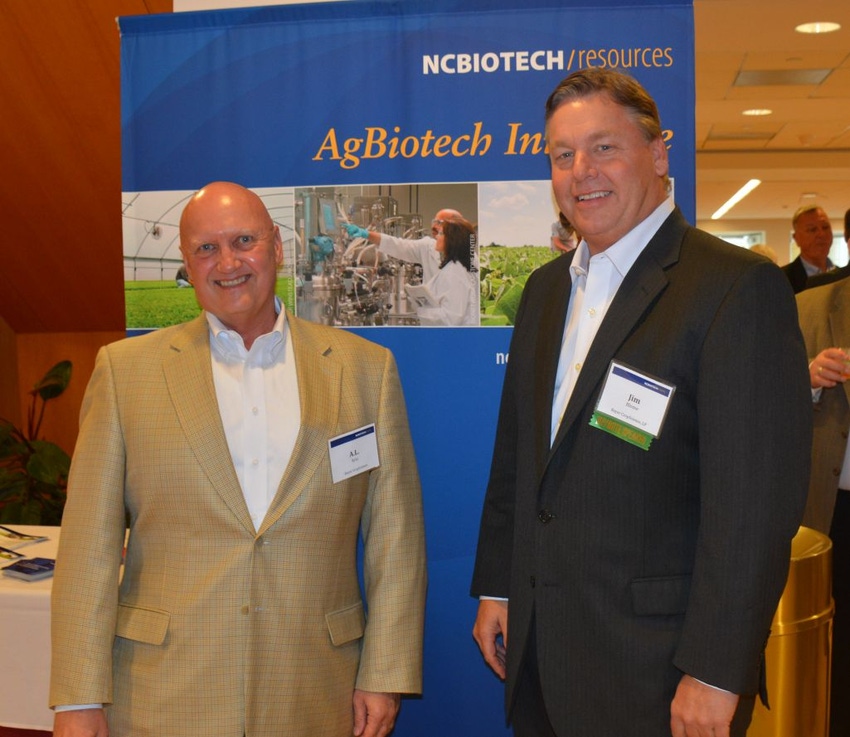
Bayer’s Jim Blome says continued innovation in agriculture is a must to meet the demands of a growing and increasingly more affluent global population.
“Some may still ask if we really need innovation. For long-term sustainability, the answer is clearly yes,” says Blome, the president and CEO and head crop protection, North American Region for Bayer CropScience. “We can’t keep cutting down trees and plowing up forests to make new farmland. Quite frankly, that’s been done. There’s not any more arable land so our challenge of doubling our yields on the current arable land is going to take new innovation, new technology.”
Speaking at the Ag Biotech Entrepreneurial Showcase at the North Carolina Biotechnology Center in Research Triangle Park May 18, Blome described all the new technology in agriculture as “new ways of doing old things” with the number one goal of increasing yields.
In his comments, Blome did not discuss Bayer’s interest in purchasing Monsanto, but he did discuss mergers in the agricultural sector. Blome called all the consolidation in the marketplace an “interesting dynamic that is real and begs the question, ‘Why now?’”
(Editor’s note: On May 24, and after the interview for this Southeast Farm Press story, Monsanto Board of Directors unanimously said it views “the Bayer AG proposal as incomplete and financially inadequate, but is open to continued and constructive conversations to assess whether a transaction in the best interest of Monsanto shareowners can be achieved.” Bayer offered, it was reported, to buy Monsanto for $62 billion, or what Bayer said is $122 per share all-cash proposal.)
“Investment is a long-term proposal. It’s not just the current low commodity prices, although they are not helping. But if you look at it, it’s really the re-definition of size and scale,” Blome said of all the consolidation in the industry.
$1.1 billion a year on R&D
“We spend at Bayer CropScience about $1.1 billion a year on R&D, and that’s a hefty amount,” he said. “You can’t keep doing that if you don’t have some successes and luckily we keep the machine going by having some output every year. But every year, more and more of that research budget is not going to new discovery research. It’s being use to defend older products. It’s stealing from the innovation machine that we created.
"I really believe that is part of the consolidation pressure, just redefining this new size and scale and what it takes to be successful in this space of bringing new innovation to the marketplace," he said.
In essence, Blome says the need for innovation in agriculture boils down to identifying and fixing yield limiting factors.
“That’s not new,” he stressed. “Agronomists have been doing that for the entire time we have been farming as a specialized profession. But now the agronomists and the scientists have great new sophisticated tools, and that’s what we are about in innovation. You have to have your eyes open; you have to look everywhere for innovation and it can come from anywhere.”
Stay current on what’s happening in Southeast agriculture: Subscribe to Southeast Farm Press Daily.
Blome said farmers today are more sophisticated than ever. “Our technologies are focused on two things: improving and protecting yields and managing and reducing risk. Doing those two things has always been what farming is about,” he said.
The key now is to offer farmers integrated solutions and help them manage data, Blome said. “Some farmers will honestly tell you that they have too much data and ‘what I really need instead of having all of is this data is some real time analysis and real time decision making that calculates the return on investment and helps me make a decision in real time so I can decide what I’m going to do today utilizing this data to increase my yields in an economically sustainable fashion.’”
About the Author(s)
You May Also Like






